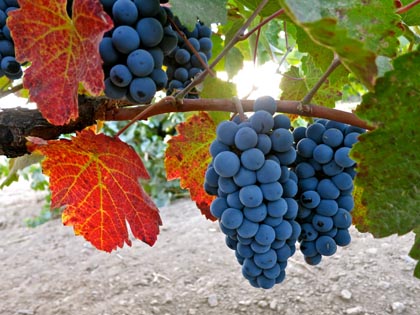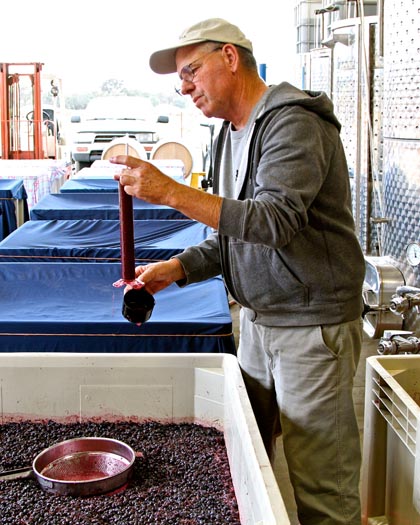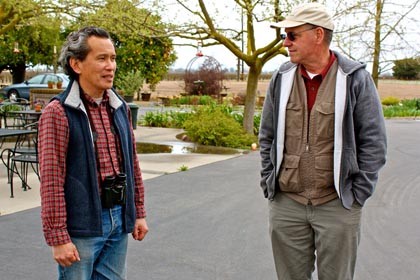Letters from Lodi
An insightful and objective look at viticulture and winemaking from the Lodi
Appellation and the growers and vintners behind these crafts. Told from the
perspective of multi-award winning wine journalist, Randy Caparoso.
The decidedly unknown (yet fantastic) Charbono grape
The near forgotten Charbono grape
In a recent polemic issued on his Web site, the widely read wine critic Robert M. Parker Jr. commented on the disproportionate attention paid to "unknown" grapes by some of the new "absolutists":
“What we also have from this group of absolutists is a near-complete rejection of some of the finest grapes and the wines they produce. Instead they espouse, with enormous gusto and noise, grapes and wines that are virtually unknown. That’s their number one criteria – not how good it is, but how obscure it is”
Tom Hoffman of Lodi’s Heritage Oak
Ouch. It's been said that Mr. Parker is the single most influential person in the wine world; which makes makes his indictment even sadder. What if you happen to think that certain wines made from lesser known grapes – such as Vermentino or Verdelho, Trollinger or Ribolla Gialla – are fantastic? Wines that you want to drink all the time; not because they are obscure, but because you love ‘em. Does that mean you're wrong, because Mr. Parker says so? Does this mean that, in order to have good taste, you must stick to wines made from the classic grapes, like Cabernet Sauvignon, Merlot or Chardonnay?
The answer, of course, is you're not wrong. You’re not a yahoo, and your taste is as good as anyone's. In fact, your taste is the only one that matters – after all, it's your palate, and your wallet. If you love Merlot or Chardonnay you should enjoy them; but who's to say that a Teroldego, a Zweigelt, a Pinotage or a Graciano can't be just as great in your book — especially if you’re bored of Merlot or Chardonnay?
Not to pile on, but with all (and properly fearful) respect, Mr. Parker may also be revealing an unseemly regional (not just grape) bias. A variety like Vermentino, for instance, might be considered obscure in the U.S., but in its native wine regions — France’s Corsica and Provence, and also Italy’s Sardinia — it pretty much rules the roost as a numero uno white wine grape, in terms of quality, quantity and prestige. The same thing for Ribolla Gialla in Slovenia and Italy’s Friuli-Venezia Giulia, Zweigelt in Austria, Pinotage in South Africa, and many other cultivars valued much more elsewhere. What’s “unknown” here is often a big deal in other wine regions, where they make the finest wines. “Classic” is in the eye of the beholder — yours and Mr. Parker’s alike.
Of all the Vitis vinifera in the world, the one grape that has been most often called the "Rodney Dangerfield" of wines – something that gets no respect – is the grape known to us as Charbono. Few wine lovers have heard of Charbono, and avid enthusiasts of the grape probably add up to, say, a few dozen. Because of that, less than a dozen wineries in the U.S. even bother making a wine out of Charbono – despite its thick black skin, ideally suitable for production of dark, sturdy, yet amazingly well balanced red wines.
There are, thank goodness, a couple of well respected winemakers in Lodi who produce wines from this grape of ill repute: Antonio Pasos of Pasos Vineyards, and Tom Hoffman of Heritage Oak Winery. Yeah, that makes them rebels of sorts. Mr. Pasos is fond of Brando-like leather jackets, it is true; but Hoffman – actually, he looks more like your friendly neighborhood dentist… his passion, other than growing grapes and crafting wine, is actually playing Domenico Scarlatti on the piano (he keeps a baby grand in his tasting room, just for the pleasure of entertaining his frequent visitors!). And wild birds — Mr. Hoffman seriously loves feeding, housing, and watching birds (see one of our previous posts, the birdmen of Lodi).
Mr. Hoffman's is the latest Lodi grown release of this near forgotten grape: the 2010 Heritage Oak Lodi Charbono ($28) is already wowing us with its big (but not weighty or bludgeoning), broad, blackberryish concentration, and its thick, toothsome yet fluid feel, framed by zingy acidity and a plentitude of muscular yet suave, well rounded tannins. A "manly" red wine, if ever a wine could be like that – adventurous, hunky, sensual to the touch… something that just feels right.
Lodi grown Charbono
In the Book of California Wine (Muscatine, Amerine, Thompson), it is written that Charbono has been grown in California since the 1880s; but for the longest time nobody really knew where it came from. They could only hazard guesses – not unusual in a state where, for most of the last century, Petite Sirah was thought to be synonymous with Syrah (it is not), Napa Gamay and Gamay Beaujolais were considered the same as the Gamay Noir of France's Beaujolais region (which they aren't), Sylvaner and Gray Riesling were assumed to be variants of Riesling (not true), Chardonnay was considered a "Pinot" grape (also not true), and varietals like Pinot St. George (properly known as Négrette – part of the reason it is no longer desired) and Green Hungarian (Butschera, in Hungary) were still fairly popular among consumers.
Ah, ye olde days — when there were no Parkers reminding us what we’re supposed to be drinking. Heck, right here in Lodi the grapes from the region's oldest planting (the Bechthold Vineyard, dating back to 1886) were farmed for well over 100 years as Black Malvoise, which is why nobody wanted them. It wasn't until 2004, when the grapes were finally identified as Cinsaut – a far more coveted Rhône grape – that hot-shot wineries started to line up to buy them (and now there's a waiting list – as well as should be!).
Inglenook, that classic Napa Valley brand of yesteryears, developed quite a reputation for Charbono; planted for decades in a place of honor, right in front the old winery's gigantic wood doors. Inglenook Charbonos from the 1940s to 1960s were known to age beautifully – as long or longer than the winery's venerated Cabernet Sauvignons, for up to 30 years. Back then, California producers speculated that Charbono might be related to Italy's Barbera, or Pinot Noir from France. They were very wrong. It wasn't until 1999 that U.C. Davis' Carole Meredith conclusively identified the grape, through DNA analysis, as being identical to the grape called Douce Noir, native of France's Savoie region (where it is also known as Corbeau).
Corbeau, a.k.a. Douce Noir, is also the grape grown and bottled in Argentina as Bonarda, which you see on occasion on varietally labeled imports brought into the U.S. While France's Savoie has a continental climate – as opposed to the Mediterranean climate of Napa Valley, Lodi, and Argentina – the grape we have known as Charbono or Bonarda has continued to thrive in the New World, producing unusually organoleptic wines: that is, red wines that are stronger in a sensory appeal emerging in the mouth, rather than through aromas perceived immediately in the nose, which tends to be subtle. But there's nothing like a wine that sneaks up on you like that – shyly scented, but seeming to grow, and enthrall the senses, with every flavorful sip, while couched in a typically harmonious balance of alcohol (not light, but rarely higher than 14.5%), and tied together by generous yet rounded tannin in combination with notably zesty natural acidity.
Charbono may not be famous, and will probably never merit a "100" in one of Mr. Parker's books. But this has never kept it from being what it truly is: a fantastically noble red wine!
Tom Hoffman with resident ornithologist David Yee




